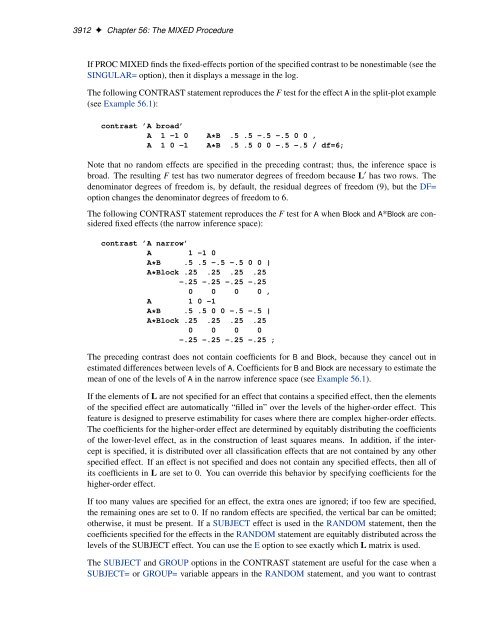SAS/STAT 9.2 User's Guide: The MIXED Procedure (Book Excerpt)
SAS/STAT 9.2 User's Guide: The MIXED Procedure (Book Excerpt)
SAS/STAT 9.2 User's Guide: The MIXED Procedure (Book Excerpt)
You also want an ePaper? Increase the reach of your titles
YUMPU automatically turns print PDFs into web optimized ePapers that Google loves.
3912 ✦ Chapter 56: <strong>The</strong> <strong>MIXED</strong> <strong>Procedure</strong><br />
If PROC <strong>MIXED</strong> finds the fixed-effects portion of the specified contrast to be nonestimable (see the<br />
SINGULAR= option), then it displays a message in the log.<br />
<strong>The</strong> following CONTRAST statement reproduces the F test for the effect A in the split-plot example<br />
(see Example 56.1):<br />
contrast ’A broad’<br />
A 1 -1 0 A*B .5 .5 -.5 -.5 0 0 ,<br />
A 1 0 -1 A*B .5 .5 0 0 -.5 -.5 / df=6;<br />
Note that no random effects are specified in the preceding contrast; thus, the inference space is<br />
broad. <strong>The</strong> resulting F test has two numerator degrees of freedom because L 0 has two rows. <strong>The</strong><br />
denominator degrees of freedom is, by default, the residual degrees of freedom (9), but the DF=<br />
option changes the denominator degrees of freedom to 6.<br />
<strong>The</strong> following CONTRAST statement reproduces the F test for A when Block and A*Block are considered<br />
fixed effects (the narrow inference space):<br />
contrast ’A narrow’<br />
A 1 -1 0<br />
A*B .5 .5 -.5 -.5 0 0 |<br />
A*Block .25 .25 .25 .25<br />
-.25 -.25 -.25 -.25<br />
0 0 0 0 ,<br />
A 1 0 -1<br />
A*B .5 .5 0 0 -.5 -.5 |<br />
A*Block .25 .25 .25 .25<br />
0 0 0 0<br />
-.25 -.25 -.25 -.25 ;<br />
<strong>The</strong> preceding contrast does not contain coefficients for B and Block, because they cancel out in<br />
estimated differences between levels of A. Coefficients for B and Block are necessary to estimate the<br />
mean of one of the levels of A in the narrow inference space (see Example 56.1).<br />
If the elements of L are not specified for an effect that contains a specified effect, then the elements<br />
of the specified effect are automatically “filled in” over the levels of the higher-order effect. This<br />
feature is designed to preserve estimability for cases where there are complex higher-order effects.<br />
<strong>The</strong> coefficients for the higher-order effect are determined by equitably distributing the coefficients<br />
of the lower-level effect, as in the construction of least squares means. In addition, if the intercept<br />
is specified, it is distributed over all classification effects that are not contained by any other<br />
specified effect. If an effect is not specified and does not contain any specified effects, then all of<br />
its coefficients in L are set to 0. You can override this behavior by specifying coefficients for the<br />
higher-order effect.<br />
If too many values are specified for an effect, the extra ones are ignored; if too few are specified,<br />
the remaining ones are set to 0. If no random effects are specified, the vertical bar can be omitted;<br />
otherwise, it must be present. If a SUBJECT effect is used in the RANDOM statement, then the<br />
coefficients specified for the effects in the RANDOM statement are equitably distributed across the<br />
levels of the SUBJECT effect. You can use the E option to see exactly which L matrix is used.<br />
<strong>The</strong> SUBJECT and GROUP options in the CONTRAST statement are useful for the case when a<br />
SUBJECT= or GROUP= variable appears in the RANDOM statement, and you want to contrast

















